Balancing Submarine Landslides and the Marine Economy for Sustainable Development: A Review and Future Prospects
Abstract
1. Introduction
2. Fundamental Principles of Submarine Landslides
2.1. Spatial Distribution of Submarine Landslides
2.2. Categorization of Submarine Landslides
2.3. Inducement and Characteristics of Submarine Landslides
- (1)
- Earthquake and active fault activity: Active fault activity can increase the dip angle of the submarine slope body and transfer energy from the underlying bedrock to the seabed surface sediments, which not only amplifies the shear force of the slope body, but also diminishes the strength of the soil mass due to vibration liquefaction. Mean-while, the active fault serves as a crucial conduit for natural gas migration, enabling deep-seated gases to ascend along the active fault plane and facilitate the development of potential slip surfaces [102]. On the other hand, while submarine earthquakes can directly induce slope instability, they also have the potential to trigger tsunamis that exacerbate such instability. In the northern part of the South China Sea, a multitude of large active faults have developed at the base of the Baiyun seabed landslide, extending vertically for thousands of meters. The seismic reflection characteristics of the strata exhibit polarity reversal and high amplitude anomalies, which are distributed on both sides of or at the top of the active fault plane, potentially serving as a primary trigger for landslide disasters [103].
- (2)
- Natural Gas hydrate decomposition: Natural gas hydrate (NGH) is a crystalline compound composed of water molecules that form cages trapping natural gas molecules. It typically forms under conditions of low temperature and high pressure [104]. The perturbation of external factors, such as fluctuations in the sea level, tidal movements, and earthquake events, can induce the decomposition of gas hydrates and result in the upward migration of reservoir fluids. This process disturbs the original sedimentary state that occurs naturally [105]. NGH serves as an efficient cementing agent among sediment particles, and the decomposition of the hydrate can induce alterations in the local shear stress and trigger instability in submarine slopes. Additionally, at standard temperature and pressure conditions, the decomposition of 1 m3 of hydrate yields approximately 164 m3 of methane gas (significantly exceeding its solubility in water) and 0.8 m3 of water [106]. This can lead to the volumetric expansion of the low-permeability layer, resulting in the inadequate discharge of excess water and natural gas, thereby promoting the formation of overpressured fluid. However, the reduction of effective stress in marine sediments caused by overpressure can trigger submarine landslides. Previous studies have suggested that the decomposition of gas hydrates may be linked to other triggers. For instance, global warming or alterations in ocean current patterns can result in an increase in temperatures on the seabed, which subsequently triggers gas hydrate decomposition. Furthermore, the methane generated from decomposition exacerbates the phenomenon of global warming, triggering a chain reaction that leads to more frequent undersea landslides [107]. A significant number of submarine landslides have been identified in the Pearl River Estuary Basin of the South China Sea since the 1990s [108,109]. Despite the remarkable progress made in investigating seabed surface stability within the hydrate test area of the South China Sea, further research is needed to fully understand the mechanism behind seabed instability [110,111,112].
3. Environmental and Economic Impacts Resulting from Submarine Landslides
3.1. Disturbance of Submarine Landslides by Oil and Gas Fields, Metal Mines Exploitation
- (1)
- Oil spill problems. The presence of oil and gas reserves beneath the seabed is not typically impacted by submarine landslides (Figure 6a). Nevertheless, studies have shown that submarine landslides can cause significant damage to the transportation of oil and gas in the ocean [117]. The deep-water horizon explosion in the Gulf of Mexico in 2010, which resulted in the loss of 11 lives and the release of millions of barrels of oil into the ocean, is considered one of the worst marine disasters in American history [118,119]. The South China Sea boasts abundant oil and gas reserves in its deep waters. In the deep-water area at a depth of 300 m, there are proven geological reserves of approximately 8.304 × 109 t of oil and geological resources and about 7.493 × 109 m3 of natural gas [120]. The exploration and exploitation of deep-water oil and gas resources in the South China Sea holds significant importance for alleviating China’s reliance on imported oil and enhancing its economic security coefficient.
- (2)
- Gas hydrate decomposition problems. Compared to oil, NGH is shallowly buried in the seabed and its stability region is affected by submarine landslides, which primarily manifest as changes in temperature and pressure of the seafloor and cap layer [121]. The formation and decomposition of submarine gas hydrates are directly influenced by the hydrostatic pressure, submarine temperature, composition of the gas source, pore water salinity, and other factors. As a geological hazard factor, the impact of NGH on offshore oil and gas exploration is manifested through its decomposition-induced non-uniformity in formation bearing capacity. Additionally, the abrupt release of gas can cause detrimental effects on the pipeline, particularly when high-pressure shallow gas is released, which may result in welling and blowout phenomena that could lead to marine ecological damage, geological collapse, submarine landslides, seawater poisoning, and other disasters [122]. Offshore oil production facilities often sit on top of hydrate stability zones, and the destabilization of these hydrates can pose a direct threat to the submarine oil and gas production infrastructure, potentially leading to platform sinking and pipeline damage. Therefore, the prolonged exposure of deep-sea pipelines and underwater wellheads to hydrates poses a potential hazard. Due to methane’s greenhouse effect being dozens of times greater than that of carbon dioxide, the decomposition of hydrates not only impacts global climate change but also has significant environmental implications [123,124].
- (3)
- Metal ore energy mining problems. From 2000 to 2020, China conducted trials of deep-sea mining systems at various water depths, demonstrating its commitment to advancing technological capabilities in the exploration and exploitation of ocean resources [125,126]. Numerous studies have demonstrated that the typical size of deep-sea polymetallic nodules ranges from 20 to 100 mm [127], while extracting polymetallic sulfides and cobalt-rich crusts necessitates cutting and stripping, resulting in mineral particles as large as tens of centimeters [128]. Deep-sea polymetallic nodules, polymetallic sulfides, and cobalt-rich crusts are found at water depths of 4000–6000 m, 500–3700 m, and 800–2400 m, respectively. As a result, the distance between the seabed and mineral transportation in deep-sea mining is often several kilometers greater than that of marine oil and gas extraction at present (Figure 6b). The development and application of mining equipment face new technological and cost-related challenges. On the other hand, frequent seismic activity in the South China Sea can lead to catastrophic submarine landslides, exacerbating the challenges and hazards of deep-sea mining. Since the fourteenth Five-Year Plan, the Chinese government has introduced a sustainable development strategy for the ocean, which emphasizes minimizing marine pollution during mineral upgrading processes [129]. To prevent mining discharges from polluting the ocean surface, the proposed scheme involves returning the dehydrated wastewater from pulp to the ocean floor. Accordingly, the sustainable development of deep-sea mining necessitates adherence to fundamental requirements such as safety, reliability, environmental protection, cost-effectiveness, and longevity [130,131,132].
3.2. Analysis of Environmental Pollution and Economic Loss Induced by Submarine Landslides
4. Comprehensive Application of Submarine Landslide Technologies
4.1. Numerical Simulations of Landslide-Impacted Pipelines
4.2. Model Testing of Pipeline Response to Landslide Impact
4.3. Analysis of Submarine Landslide Impact on Other Deep-Sea Facilities
5. Conclusions and Prospects
- (1)
- Submarine landslide hotspots are predominantly concentrated in the Pacific, Atlantic, and Indian Oceans, with notable occurrences in northern Brazil and eastern Venezuela, as well as the eastern, western, and southern regions of the United States. The classification criteria for submarine landslides vary. The narrow definition refers to the process of weakly structured rock sliding rapidly along a slope under the influence of gravity, including translational and rotational landslides. Moreover, the broader concept encompasses various sediment transport processes, such as creeps, collapses, and gravity flows.
- (2)
- The primary triggering factors of submarine landslides are earthquakes and active fault activity (26.82%), rapid deposition (15.61%), and gas hydrate decomposition (7.39%). In deep-sea environments below 1000 m, seismic and active fault activity as well as natural gas hydrate decomposition are considered the two main causes. Moreover, the typical characteristics of submarine landslides typically comprise the head stretch region, body slip region, and toe extrusion region.
- (3)
- Based on investigations and predictions of the C-C area of the international seabed, it is believed that China and Mexico are currently the only production bases in the world capable of carrying out large-scale smelting and processing of deep-sea mineral resources, with promising prospects for development. Additionally, we contend that deep-sea mining offers superior economic and environmental advantages compared to land-based mining.
- (4)
- The investigation of submarine geological hazards is of great significance to the formulation and implementation of China’s marine strategy. Currently, numerical simulation and physical model testing are the primary research methods for submarine landslides. In general, the workflow of ocean engineering necessitates the investigation and assessment of geological hazards, as well as the establishment of risk plans prior to implementation. With the rapid development of China’s ocean industry, it is crucial to enhance techniques for identifying and analyzing deep-water landslide disasters, conducting in situ monitoring, and performing numerical simulations, particularly with regard to deep-sea seabed in situ monitoring. In the future, we aim to achieve sustainable development of the marine environment and economy by establishing a multi-level and multi-dimensional monitoring chain that takes into account ecological, environmental, and economic factors.
Author Contributions
Funding
Institutional Review Board Statement
Informed Consent Statement
Data Availability Statement
Conflicts of Interest
References
- Mason, B. National Academy calls for sea change in ocean efforts. Nature 2003, 426, 6. [Google Scholar] [CrossRef]
- Fakhraee, M.; Planavsky, N.J.; Reinhard, C.T. Ocean alkalinity enhancement through restoration of blue carbon ecosystems. Nat. Sustain. 2023, 6, 1087–1094. [Google Scholar] [CrossRef]
- Lévy, M.; Franks, P.J.S.; Smith, K.S. The role of submesoscale currents in structuring marine ecosystems. Nat. Commun. 2018, 9, 4758. [Google Scholar] [CrossRef]
- Zhou, Q.; Wang, S.; Liu, J.; Hu, X.; Liu, Y.; He, Y.; He, X.; Wu, X. Geological evolution of offshore pollution and its long-term potential impacts on marine ecosystems. Geosci. Front. 2022, 13, 101427. [Google Scholar] [CrossRef]
- Borrelli, L.; Antronico, L.; Le, P.E.; Pisano, B.; Sorriso, V.M. Morphology, properties, and source of windblown sediments of the coastal dune field in the Gioia Tauro Plain, Calabria, southern Italy. CATENA 2021, 201, 105193. [Google Scholar] [CrossRef]
- Sultan, N.; Savoye, B.; Jouet, G.; Leynaud, D.; Cochonat, P.; Henry, P.; Stegmann, S.; Kopf, A. Investigation of a possible submarine landslide at the Var delta front (Nice continental slope, southeast France). Can. Geotech. J. 2010, 47, 486–496. [Google Scholar] [CrossRef]
- Uno, S.; Kokushi, E.; Añ, N.; Iwai, T.; Ito, K.; Koyama, J. Oil spill off the coast of Guimaras Island, Philippines: Distributions and changes of polycyclic aromatic hydrocarbons in shellfish. Mar. Pollut. Bull. 2017, 124, 962–973. [Google Scholar] [CrossRef]
- Chen, R.H.; Deng, S.; Zhao, L.; Zhao, R.K.; Xu, W.C. Energy recovery from wastewater in deep-sea mining: Feasibility study on an energy supply solution with cold wastewater. Appl. Energy 2022, 305, 117719. [Google Scholar] [CrossRef]
- Guo, X.S.; Fan, N.; Liu, Y.H.; Liu, X.L.; Wang, Z.K.; Xie, X.T.; Jia, Y.G. Deep seabed mining: Frontiers in engineering geology and environment. Int. J. Coal Sci. Technol. 2023, 10, 23. [Google Scholar] [CrossRef]
- Murray, C.C.; Maximenko, N.; Lippiatt, S. The influx of marine debris from the Great Japan Tsunami of 2011 to North American shorelines. Mar. Pollut. Bull. 2018, 132, 26–32. [Google Scholar] [CrossRef]
- Hepburn, C.; Qi, Y.; Stern, N.; Ward, B.; Xie, C.P.; Zenghelis, D. Towards carbon neutrality and China’s 14th Five-Year Plan: Clean energy transition, sustainable urban development, and investment priorities. Environ. Sci. Ecotechnol. 2021, 8, 100130. [Google Scholar] [CrossRef]
- Yin, K.D.; Zhang, K.; Huang, C. Institutional supply, market cultivation, and the development of marine strategic emerging industries. Mar. Policy 2022, 139, 105045. [Google Scholar] [CrossRef]
- Ma, R.F.; Hou, B.; Zhang, W.Z. Could Marine Industry Promote the Coordinated Development of Coastal Provinces in China? Sustainability 2019, 11, 1053. [Google Scholar] [CrossRef]
- Yu, J.K.; Yin, W. Exploring stakeholder engagement in mariculture development: Challenges and prospects for China. Mar. Policy 2019, 103, 84–90. [Google Scholar] [CrossRef]
- Liu, Y.J.; Li, Y.; He, F.L.; Wang, H.F. Comparison study of tidal stream and wave energy technology development between China and some Western Countries. Renew. Sust. Energ. Rev. 2017, 76, 701–716. [Google Scholar] [CrossRef]
- Wang, Y.B.; Liu, J.Q.; Du, X.; Liu, Q.; Liu, X. Temporal-spatial characteristics of storm surges and rough seas in coastal areas of Mainland China from 2000 to 2019. Nat. Hazards 2021, 107, 1273–1285. [Google Scholar] [CrossRef]
- Lin, Y.F.; Dong, S.; Wang, Z.F.; Soares, C.G. Wave energy assessment in the China adjacent seas on the basis of a 20-year SWAN simulation with unstructured grids. Renew. Energ. 2019, 136, 275–295. [Google Scholar] [CrossRef]
- Zhang, W.J.; Dong, Z.J.; Zhang, C.; Sun, X.Y.; Hou, C.W.; Liu, Y.L.; Wang, L.; Ma, Y.Q.; Zhao, J.M. Effects of physical-biochemical coupling processes on the Noctiluca scintillans and Mesodinium red tides in October 2019 in the Yantai nearshore, China. Mar. Pollut. Bull. 2020, 160, 111609. [Google Scholar] [CrossRef]
- Wu, R.H.; Wu, S.M.; Chen, T.H.; Yang, Q.H.; Han, B.; Zhang, H. Effects of Wave-Current Interaction on the Eastern China Coastal Waters during Super Typhoon Lekima (2019). J. Phys. Oceanogr. 2021, 51, 1611–1636. [Google Scholar] [CrossRef]
- Runa, A.; Cui, T.W.; Qing, S.; Wei, T.; Mu, B.; Xiao, Y.F.; Chen, Y.L.; Bao, Y.H.; Zhang, J. Decade-low aerosol levels over the Bohai and Yellow Seas amid the COVID-19 lockdown. Int. J. Appl. Earth Obs. 2022, 112, 102905. [Google Scholar]
- Yang, Y.; Ren, L.; Wu, M.; Wang, H.; Song, F.; Leung, L.; Hao, X.; Li, J.; Chen, L.; Li, H.; et al. Abrupt emissions reductions during COVID-19 contributed to record summer rainfall in China. Nat. Commun. 2022, 13, 959. [Google Scholar] [CrossRef]
- Al-Shehhi, M.R.; Samad, Y.A. Effects of the COVID-19 pandemic on the oceans. Remote Sens. Lett. 2021, 12, 325–334. [Google Scholar] [CrossRef]
- Thorne, K.; Jones, S.; Freeman, C.; Buffington, K.; Janousek, C.; Guntenspergen, G. Atmospheric River Storm Flooding Influences Tidal Marsh Elevation Building Processes. J. Geophys. Res-Biogeo. 2022, 127, e2021JG006592. [Google Scholar] [CrossRef]
- Inda, H.; García-Rodríguez, F.; Puerto, L.; Stutz, S.; Figueira, R.C.L.; Ferreira, P.A.D.; Mazzeo, N. Discriminating between natural and human-induced shifts in a shallow coastal lagoon: A multidisciplinary approach. Anthropocene 2016, 16, 1–15. [Google Scholar] [CrossRef]
- Goldfinger, C. Submarine Paleoseismology Based on Turbidite Records. Annu. Rev. Mar. Sci. 2011, 3, 35–66. [Google Scholar] [CrossRef] [PubMed]
- Anderson, D.M.; Fensin, E.; Gobler, C.J.; Hoeglund, A.E.; Hubbard, K.A.; Kulis, D.M.; Landsberg, J.H.; Lefebvre, K.A.; Provoost, P.; Richlen, M.L.; et al. Marine harmful algal blooms (HABs) in the United States: History, current status and future trends. Harmful Algae 2021, 102, 101975. [Google Scholar] [CrossRef] [PubMed]
- Jia, Y.G.; Chen, T.; Li, P.Y.; Li, Z.H.; Hu, C.; Liu, X.L.; Shan, H.X. Research progress on the in-situ monitoring technologies of marine geohazards. Chin. J. Geol. Hazard Control. 2022, 33, 1–14. [Google Scholar]
- Ward, P.D.; Haggart, J.W.; Carter, E.S.; Wilbur, D.; Tipper, H.W.; Evans, T. Sudden productivity collapse associated with the Triassic-Jurassic boundary mass extinction. Science 2001, 292, 1148–1151. [Google Scholar] [CrossRef]
- Valle, L.A.; Olabarrieta, M.; Heilman, L. Compound flooding in Houston-Galveston Bay during Hurricane Harvey. Sci. Total Environ. 2020, 747, 141272. [Google Scholar] [CrossRef]
- Sprovieri, M.; Cucco, A.; Budillon, F.; Manta, D.S.; Trincardi, F.; Passaro, S. Large-Scale Mercury Dispersion at Sea: Modelling a Multi-Hazard Case Study from Augusta Bay (Central Mediterranean Sea). Int. J. Environ. Res. Public Health 2022, 19, 3956. [Google Scholar] [CrossRef]
- Meslard, F.; Balouin, Y.; Robin, N.; Bourrin, F. Assessing the Role of Extreme Mediterranean Events on Coastal River Outlet Dynamics. Water 2022, 14, 2463. [Google Scholar] [CrossRef]
- Audru, J.C.; Bitri, A.; Desprats, J.F.; Dominique, P.; Eucher, G.; Hachim, S.; Jossot, O.; Mathon, C.; Nedellec, J.L.; Sabourault, P.; et al. Major natural hazards in a tropical volcanic island: A review for Mayotte Island, Comoros archipelago, Indian Ocean. Eng. Geol. 2010, 114, 364–381. [Google Scholar] [CrossRef]
- Chadwick, W.W.; Dziak, R.P.; Haxel, J.H.; Embley, R.W.; Matsumoto, H. Submarine landslide triggered by volcanic eruption recorded by in situ hydrophone. Geology 2012, 40, 51–54. [Google Scholar] [CrossRef]
- Wang, F.W.; Dai, Z.L.; Nakahara, Y.; Sonoyama, T. Experimental study on impact behavior of submarine landslides on undersea communication cables. Ocean Eng. 2018, 148, 530–537. [Google Scholar] [CrossRef]
- Zengaffinen-Morris, T.; Urgeles, R.; Lovholt, F. On the Inference of Tsunami Uncertainties From Landslide Run-Out Observations. J. Geophys. Res. Oceans 2022, 127, e2021JC018033. [Google Scholar] [CrossRef]
- Fan, W.Y.; McGuire, J.J.; Shearer, P.M. Abundant Spontaneous and Dynamically Triggered Submarine Landslides in the Gulf of Mexico. Geophys. Res. Lett. 2020, 47, e2020GL087213. [Google Scholar] [CrossRef]
- Chain reaction. Nat. Geosci. 2011, 4, 269. [CrossRef][Green Version]
- Zubair, M.; Ahmed, R.; Heo, G. Quantitative and qualitative analysis of safety parameters in nuclear power plants. Int. J. Energ. Res. 2014, 38, 755–764. [Google Scholar] [CrossRef]
- Koo, Y.H.; Yang, Y.S.; Song, K.W. Radioactivity release from the Fukushima accident and its consequences: A review. Prog. Nucl. Energy 2014, 74, 61–70. [Google Scholar] [CrossRef]
- Glimsdal, S.; L’Heureux, J.S.; Harbitz, C.B.; Lovholt, F. The 29th January 2014 submarine landslide at Statland, Norway-landslide dynamics, tsunami generation, and run-up. Landslides 2016, 13, 1435–1444. [Google Scholar] [CrossRef]
- Hornbach, M.J.; Braudy, N.; Briggs, R.W.; Cormier, M.H.; Davis, M.B.; Diebold, J.B.; Dieudonne, N.; Douilly, R.; Frohlich, C.; Gulick, S.P.S.; et al. High tsunami frequency as a result of combined strike-slip faulting and coastal landslides. Nat. Geosci. 2010, 3, 783–788. [Google Scholar] [CrossRef]
- Costa, P.J.M.; Dawson, S.; Ramalho, R.S.; Engel, M.; Dourado, F.; Bosnic, I.; Andrade, C. A review on onshore tsunami deposits along the Atlantic coasts. Earth-Sci. Rev. 2021, 212, 103441. [Google Scholar] [CrossRef]
- Satake, K.; Heidarzadeh, M.; Quiroz, M.; Cienfuegos, R. History and features of trans-oceanic tsunamis and implications for paleotsunami studies. Earth-Sci. Rev. 2020, 202, 103112. [Google Scholar] [CrossRef]
- Riedel, M.; King, E.L.; Cameron, G.D.M.; Blasco, S.; Conway, K.W.; Dallimore, S.R.; Rohr, K.M.M.; Jin, Y.K.; Hong, J.K. A chronology of post-glacial mass-transport deposits on the Canadian Beaufort Slope. Mar. Geol. 2021, 433, 106407. [Google Scholar] [CrossRef]
- Wang, Y.B.; Gao, D.L. Study on the marine environment limiting conditions of deepwater drilling for natural gas hydrate. Appl. Energ. 2022, 312, 118802. [Google Scholar] [CrossRef]
- Liu, W.; Duan, X.Y.; Li, Q.H.; Wan, J.F.; Zhang, X.; Fang, J.; Jiang, D.Y.; Chen, J. Analysis of pressure interval/injection and production frequency on stability of large-scale supercritical CO2 storage in salt caverns. J. Clean. Prod. 2023, 433, 139731. [Google Scholar] [CrossRef]
- Noda, A.; TuZino, T.; Joshima, M.; Goto, S. Mass transport-dominated sedimentation in a foreland basin, the Hidaka Trough, northern Japan. Geochem. Geophy. Geosy. 2013, 14, 2547–3313. [Google Scholar] [CrossRef]
- Sultan, N.; Voisset, M.; Marsset, B.; Marsset, T.; Cauquil, E.; Colliat, J.L. Potential role of compressional structures in generating submarine slope failures in the Niger Delta. Mar. Geol. 2007, 237, 169–190. [Google Scholar] [CrossRef]
- Zhu, C.Q.; Jia, Y.G.; Liu, X.L.; Zhang, H.; Wen, M.Z.; Huang, M.; Shan, H.X. Classification and genetic machanism of submarine landslide: A review. Mar. Geol. Quatern. Geol. 2015, 35, 153–163. [Google Scholar]
- Jeong, S.W.; Leroueil, S.; Locat, J. Applicability of power law for describing the rheology of soils of different origins and characteristics. Can. Geotech. J. 2009, 46, 1011–1023. [Google Scholar] [CrossRef]
- Liu, X.L.; Wang, Y.Y.; Zhang, H.; Guo, X.S. Susceptibility of typical marine geological disasters: An overview. Geoenviron. Dis. 2023, 10, 10. [Google Scholar] [CrossRef]
- Pope, E.L.; Heijnen, M.S.; Talling, P.J.; Jacinto, R.S.; Gaillot, A.; Baker, M.L.; Hage, S.; Hasenhundl, M.; Heerema, C.J.; McGhee, C.; et al. Carbon and sediment fluxes inhibited in the submarine Congo Canyon by landslide-damming. Nat. Geosci. 2022, 15, 845–853. [Google Scholar] [CrossRef]
- Chiocci, F.L.; Cattaneo, A.; Urgeles, R. Seafloor mapping for geohazard assessment: State of the art. Mar. Geophys. Res. 2011, 32, 1–11. [Google Scholar] [CrossRef]
- Fang, K.; Tang, H.M.; Li, C.D.; Su, X.X.; An, P.J.; Sun, S.X. Centrifuge modelling of landslides and landslide hazard mitigation: A review. Geosci. Front. 2023, 14, 101493. [Google Scholar] [CrossRef]
- Staudigel, H.; Clague, D.A. The geological history of deep-sea volcanoes biosphere, hydrosphere, and lithosphere interactions. Oceanography 2010, 23, 58–71. [Google Scholar] [CrossRef]
- Prior, D.B.; Jin, B. Submarine landslides: Morphology and naming. Offshore Oil. 1983, 3, 1–5. [Google Scholar]
- Chen, Z.S. A Preliminary Discussion of the Research on Submarine Landslides; China Railway Publishing House: Beijing, China, 1988; pp. 154–160. [Google Scholar]
- Lee, H.J.; Lu, F.H. Scope and significance of submarine landslides in the Pacific Ocean. Transl. Geol. Sci. 1990, 2, 15. [Google Scholar]
- Kou, Y.Q. Submarine landslide in the northern South China Sea. Mar. Coast. Zone Dev. 1990, 7, 48–51. [Google Scholar]
- Jiang, L.; Leblond, P.H. The Coupling of a submarine slide and the surface-waves which it generates. J. Geophys. Res.-Oceans. 1992, 97, 12731–12744. [Google Scholar] [CrossRef]
- Yin, K.L.; Han, Z.S.; Li, Z.Z. New progress in international landslide research. Hydrogeol. Eng. Geol. 2000, 5, 1–3. [Google Scholar]
- Zhu, M. Three-dimensional seismic characteristics of the Shanghai floor landslide of the Pliocene-Pleistocene silicicclastic continental slope in the South China Sea. AAPG 2006 Ann. Conv. 2006, 11, 136–143. [Google Scholar]
- Wu, S.G.; Chen, S.S.; Wang, Z.J.; Li, Q.P. Submarine Landslide and Risk Evaluation on Its Instability in the Deepwater Continental Margin. Geoscience 2008, 22, 430–437. [Google Scholar]
- Liu, F.; Wu, S.G.; Sun, Y.B. A quantitative analysis for submarine slope instability of the northern South China Sea due to gas hydrate dissociation. Chin. J. Geophys. 2010, 53, 946–953. [Google Scholar]
- Ruan, A.G.; Li, J.B.; Lee, C.S.; Qiu, X.L.; Pan, S.J. Passive seismic experiment and ScS wave splitting in the southwestern subbasin of South China Sea. Chin. Sci. Bull. 2012, 57, 3381–3390. [Google Scholar] [CrossRef]
- Yin, Z.Q.; Qin, X.G.; Yin, Y.P.; Zhao, W.J.; Wei, G. Landslide Developmental Characteristics and Response to Climate Change since the Last Glacial in the Upper Reaches of the Yellow River, NE Tibetan Plateau. Acta Geol. Sin. 2014, 88, 635–646. [Google Scholar] [CrossRef]
- Li, X.S.; Liu, L.J.; Li, J.G.; Gao, S.; Zhou, Q.J.; Su, T.Y. Mass movements in small canyons in the northeast of Baiyun deepwater area, north of the South China Sea. Acta Oceanol. Sin. 2015, 34, 35–42. [Google Scholar] [CrossRef]
- Zhang, X.H.; Lu, X.B. Initiation and expansion of layered fracture in sediments due to thermal-induced hydrate dissociation. J. Petrol. Sci. Eng. 2015, 133, 881–888. [Google Scholar] [CrossRef]
- Zhang, M.; Huang, Y.; Bao, Y.J. The mechanism of shallow submarine landslides triggered by storm surge. Nat. Hazards 2016, 81, 1373–1383. [Google Scholar] [CrossRef]
- Zhou, Y.G.; Chen, J.; She, Y.; Kaynia, A.M.; Huang, B.; Chen, Y.M. Earthquake response and sliding displacement of submarine sensitive clay slopes. Eng. Geol. 2017, 227, 69–83. [Google Scholar] [CrossRef]
- Cheng, W.B.; Wu, Y.R.; Liang, C.W.; Lin, J.Y.; Hsu, S.K. Imaging P- and S-wave velocity structures in hydrate bearing sediments along an OBS profile across the Yuan-An Ridge, off southwest Taiwan. Terr. Atmos. Ocean. Sci. 2018, 29, 39–50. [Google Scholar] [CrossRef]
- Jiang, M.J.; Shen, Z.F.; Wu, D. CFD-DEM simulation of submarine landslide triggered by seismic loading in methane hydrate rich zone. Landslides 2018, 15, 2227–2241. [Google Scholar] [CrossRef]
- Sun, X.; Wang, L.; Luo, H.; Song, Y.C.; Li, Y.H. Numerical modeling for the mechanical behavior of marine gas hydrate-bearing sediments during hydrate production by depressurization. J. Petrol. Sci. Eng. 2019, 177, 971–982. [Google Scholar] [CrossRef]
- Zhang, W.C.; Randolph, M.F.; Puzrin, A.M.; Wang, D. Criteria for planar shear band propagation in submarine landslides along weak layers. Landslides 2020, 17, 855–876. [Google Scholar] [CrossRef]
- Zhang, W.C.; Puzrin, A.M. Depth integrated modelling of submarine landslide evolution. Landslides 2021, 18, 3063–3084. [Google Scholar] [CrossRef]
- Wang, Y.X.; Wang, R.; Zhang, J.M. Large-scale seismic seafloor stability analysis in the South China Sea. Ocean Eng. 2021, 235, 109334. [Google Scholar] [CrossRef]
- Xie, Z.J.; Li, S.Y.; Lyu, Y.J.; Xu, W.J.; Zhang, Y.L. Empirical relations for conversion of surface- and body-wave magnitudes to moment magnitudes in China’s seas and adjacent areas. J. Seismol. 2021, 25, 213–233. [Google Scholar] [CrossRef]
- Nian, T.K.; Song, X.L.; Zhao, W.; Jiao, H.B.; Guo, X.S. Submarine slope failure due to overpressure fluid associated with gas hydrate dissociation. Environ. Geotech. 2022, 9, 108–123. [Google Scholar] [CrossRef]
- Li, Z.H.; Chen, T.; Liu, H.L.; Ji, C.S.; Zhu, C.Q.; Hu, C.; Jia, Y.G. Earthquake response and post-earthquake stability assessment of submarine clay slopes. Appl. Ocean Res. 2022, 127, 103322. [Google Scholar] [CrossRef]
- Guo, X.S.; Stoesser, T.; Zheng, D.F.; Luo, Q.Y.; Liu, X.L.; Nian, T.K. A methodology to predict the run-out distance of submarine landslides. Comput. Geotech. 2023, 153, 105073. [Google Scholar] [CrossRef]
- Liu, J.F.; Li, S.; Duan, G.J. Steady rheological behavior and unified strength model for reconstituted deep-sea sediments. Eng. Geol. 2023, 316, 107058. [Google Scholar] [CrossRef]
- Armour, K.C.; Marshall, J.; Scott, J.R.; Donohoe, A.; Newsom, E.R. Southern Ocean warming delayed by circumpolar upwelling and equatorward transport. Nat. Geosci. 2016, 9, 549–554. [Google Scholar] [CrossRef]
- Locat, J.; Lee, H.J. Submarine landslides: Advances and challenges. Can. Geotech. J. 2002, 39, 193–212. [Google Scholar] [CrossRef]
- Nian, T.K.; Guo, X.S.; Zheng, D.F.; Xiu, Z.X.; Jiang, Z.B. Susceptibility assessment of regional submarine landslides triggered by seismic actions. Appl. Ocean. Res. 2019, 93, 101964. [Google Scholar] [CrossRef]
- Guo, X.S.; Zheng, D.F.; Nian, T.K.; Lv, L.T. Large-scale seafloor stability evaluation of the northern continental slope of South China Sea. Mar. Georesour. Geotec. 2020, 38, 804–817. [Google Scholar] [CrossRef]
- Brothers, D.S.; Haeussler, P.J.; Liberty, L.; Finlayson, D.; Geist, E.; Labay, K.; Byerly, M. A submarine landslide source for the devastating 1964 Chenega tsunami, southern Alaska. Earth Planet. Sc. Lett. 2016, 438, 112–121. [Google Scholar] [CrossRef]
- Jiang, M.J.; Sun, C.; Crosta, G.B.; Zhang, W.C. A study of submarine steep slope failures triggered by thermal dissociation of methane hydrates using a coupled CFD-DEM approach. Eng. Geol. 2015, 190, 1–16. [Google Scholar] [CrossRef]
- Prior, D.B.; Coleman, J.M. Submarine landslides—Geometry and nomenclature. Z. Geomorphol. 1982, 4, 21–33. [Google Scholar]
- Mulder, T.; Cochonat, P. Classification of offshore mass movements. J. Sediment. Res. 1996, 66, 43–57. [Google Scholar]
- Masson, D.G.; Harbitz, C.B.; Wynn, R.B.; Pedersen, G.; Lovholt, F. Submarine landslides: Processes, triggers and hazard prediction. Philos. T. R. Soc. A. 2006, 364, 1845. [Google Scholar] [CrossRef]
- Moscardelli, L.; Wood, L. New classification system for mass transport complexes in offshore Trinidad. Basin Res. 2008, 20, 73–98. [Google Scholar] [CrossRef]
- Shanmugam, G. The landslide problem. J. Palaeogeog. 2015, 4, 109–166. [Google Scholar] [CrossRef]
- Sassa, S.; Takagawa, T. Liquefied gravity flow-induced tsunami: First evidence and comparison from the 2018 Indonesia Sulawesi earthquake and tsunami disasters. Landslides 2019, 16, 195–200. [Google Scholar] [CrossRef]
- Wang, W.W.; Wang, D.W.; Wu, S.G.; Volker, D.; Zeng, H.L.; Cai, G.Q.; Li, Q.P. Submarine landslides on the north continental slope of the South China Sea. J. Ocean. Univ. China 2018, 17, 83–100. [Google Scholar] [CrossRef]
- Wang, F.T.; Zhao, B.; Li, G. Prevention of Potential Hazards Associated with Marine Gas Hydrate Exploitation: A Review. Energies 2018, 11, 2384. [Google Scholar] [CrossRef]
- Feng, W.K.; Shi, Y.H.; Chen, L.H. Research for seafloor landslide statistics on the outer continental shelf and the upper continental slope in the northern South China Sea. Mar. Geol. Quatern. Geol. 1994, 14, 81–94. [Google Scholar]
- Li, Q.H.; Song, D.Q.; Yuan, C.M.; Nie, W. An image recognition method for the deformation area of open-pit rock slopes under variable rainfall. Measurement 2022, 188, 110544. [Google Scholar] [CrossRef]
- Yuan, C.M.; Li, Q.H.; Nie, W.; Ye, C.Y. A depth information-based method to enhance rainfall-induced landslide deformation area identification. Measurement 2023, 219, 113288. [Google Scholar] [CrossRef]
- Tappin, D.R.; Watts, P.; Grilli, S.T. The Papua New Guinea tsunami of 17 July 1998: Anatomy of a catastrophic event. Nat. Hazards Earth Syst. Sci. 2008, 8, 243–266. [Google Scholar] [CrossRef]
- Prior, D.B.; Coleman, J.M. Active slides and flows in underconsolidated marine sediments on the slopes of the Mississippi Delta. In Marine Slides and Other Mass Movements; Saxov, S., Nieuwenhuis, J.K., Eds.; NATO Conference Series; Springer: Boston, MA, USA, 1982; Volume 6, pp. 21–49. [Google Scholar]
- Hance, J.J. Development of a Database and Assessment of Seafloor Slope Stability Based on Published Literature. Master’s Thesis, University of Texas at Austin, Austin, TX, USA, 2003. [Google Scholar]
- Yamashita, F.; Fukuyama, E.; Xu, S.Q.; Kawakata, H.; Mizoguchi, K.; Takizawa, S. Two end-member earthquake preparations illuminated by foreshock activity on a meter-scale laboratory fault. Nat. Commun. 2021, 12, 4302. [Google Scholar] [CrossRef]
- Sun, Q.L.; Wang, Q.; Shi, F.Y.; Alves, T.; Gao, S.; Xie, X.N.; Wu, S.G.; Li, J.B. Runup of landslide-generated tsunamis controlled by paleogeography and sea-level change. Commun. Earth Environ. 2022, 3, 244. [Google Scholar] [CrossRef]
- Li, Y.L.; Liu, L.L.; Jin, Y.R.; Wu, N.Y. Characterization and development of natural gas hydrate in marine clayey-silt reservoirs: A review and discussion. Adv. Geo-Energ. Res. 2021, 5, 75–86. [Google Scholar] [CrossRef]
- Liu, W.; Du, J.W.; Li, Q.H.; Shi, X.L.; Chen, J.; Yi, W.K.; He, T.; Li, D.P.; Dong, Y.K.; Jiang, D.Y.; et al. Feasibility analysis on the utilization of TWH-caverns with sediment space for gas storage: A case study of Sanshui salt mine. J. Energy Storage 2024, 75, 109576. [Google Scholar] [CrossRef]
- Zhong, J.R.; Sun, Y.F.; Li, W.Z.; Xie, Y.; Chen, G.J.; Sun, C.Y.; Yang, L.Y.; Qin, H.B.; Pang, W.X.; Li, Q.P. Structural transition range of methane-ethane gas hydrates during decomposition below ice point. Appl. Energy 2019, 250, 873–881. [Google Scholar] [CrossRef]
- Yamamoto, A.; Yamanaka, Y.; Oka, A.; Abe-Ouchi, A. Ocean oxygen depletion due to decomposition of submarine methane hydrate. Geophys. Res. Lett. 2014, 41, 5075–5083. [Google Scholar] [CrossRef]
- Ren, Z.Y.; Zhao, X.; Liu, H. Numerical study of the landslide tsunami in the South China Sea using Herschel-Bulkley rheological theory. Phys. Fluids 2019, 31, 056601. [Google Scholar] [CrossRef]
- Chen, D.X.; Zhang, G.X.; Dong, D.D.; Zhao, M.X.; Wang, X.J. Widespread Fluid Seepage Related to Buried Submarine Landslide Deposits in the Northwestern South China Sea. Geophys. Res. Lett. 2022, 49, e2021GL096584. [Google Scholar] [CrossRef]
- Zhu, Y.H.; Wang, P.K.; Pang, S.J.; Zhang, S.; Xiao, R. A Review of the Resource and Test Production of Natural Gas Hydrates in China. Energy Fuels 2021, 35, 9137–9150. [Google Scholar] [CrossRef]
- Wang, L.; Sun, X.; Shen, S.; Wu, P.; Liu, T.; Liu, W.G.; Zhao, J.F.; Li, Y.H. Undrained triaxial tests on water-saturated methane hydrate-bearing clayey-silty sediments of the South China Sea. Can. Geotech. J. 2021, 58, 351–366. [Google Scholar] [CrossRef]
- Wang, L.; Li, Y.H.; Shen, S.; Liu, W.G.; Sun, X.; Liu, Y.; Zhao, J.F. Mechanical behaviours of gas-hydrate-bearing clayey sediments of the South China Sea. Environ. Geotech. 2022, 9, 210–222. [Google Scholar] [CrossRef]
- White, N.; Mckenzie, D. Formation of the “steer’s head” geometry of sedimentary basins by differential stretching of the crust and mantle. Geology 1988, 16, 250–253. [Google Scholar] [CrossRef]
- Abu, C.; Jackson, C.A.L.; Francis, M. Strike-slip overprinting of initial co-axial shortening within the toe region of a submarine landslide and a model for basal shear surface growth: A case study from the Angoche Basin, offshore Mozambique. J. Geol. Soc. London 2022, 179, jgs2021-032. [Google Scholar] [CrossRef]
- Fu, C.; Yu, X.H.; Fan, X.; He, Y.L.; Liang, J.Q.; Li, S.L. Classification of mass-transport complexes and distribution of gashydrate-bearing sediments in the northeastern continental slope of the South China Sea. Front. Earth Sci. 2020, 14, 25–36. [Google Scholar] [CrossRef]
- Song, Y.C.; Yang, L.; Zhao, J.F.; Liu, W.G.; Yang, M.J.; Li, Y.H.; Liu, Y.; Li, Q.P. The status of natural gas hydrate research in China: A review. Renew. Sust. Energy Rev. 2014, 31, 778–791. [Google Scholar] [CrossRef]
- Chen, X.; Bose, N.; Brito, M.; Khan, F.; Millar, G.; Bulger, C.; Zou, T. Risk-based path planning for autonomous underwater vehicles in an oil spill environment. Ocean Eng. 2022, 266, 113077. [Google Scholar] [CrossRef]
- Rohal, M.; Ainsworth, C.; Lupher, B.; Montagna, P.A.; Paris, C.B.; Perlin, N.; Suprenand, P.M.; Yoskowitz, D. The effect of the Deepwater Horizon oil spill on two ecosystem services in the Northern Gulf of Mexico. Environ. Modell. Softw. 2020, 133, 104793. [Google Scholar] [CrossRef]
- Rosenheim, B.E.; Pendergraft, M.A.; Flowers, G.C.; Carney, R.; Sericano, J.L.; Amer, R.M.; Chanton, J.; Dincer, Z.; Wade, T.L. Employing extant stable carbon isotope data in Gulf of Mexico sedimentary organic matter for oil spill studies. Deep-Sea Res. Pt. II 2016, 129, 249–258. [Google Scholar] [CrossRef]
- Owen, N.A.; Schofield, C.H. Disputed South China Sea hydrocarbons in perspective. Mar. Policy 2012, 36, 809–822. [Google Scholar] [CrossRef]
- Ma, S.H.; Zheng, J.N.; Tang, D.W.; Lv, X.; Li, Q.P.; Yang, M.J. Experimental investigation on the decomposition characteristics of natural gas hydrates in South China Sea sediments by a micro-differential scanning calorimeter. Appl. Energy 2019, 254, 113653. [Google Scholar] [CrossRef]
- Zheng, L.; Yapa, P.D.; Chen, F.H. A model for simulating deepwater oil and gas blowouts—Part I: Theory and model formulation. J. Hydraul. Res. 2003, 41, 339–351. [Google Scholar] [CrossRef]
- Amstel, A.V. Methane. A review. J. Integr. Environ. Sci. 2012, 9, 5–30. [Google Scholar] [CrossRef]
- Shoemaker, J.K.; Schrag, D.P. The danger of overvaluing methane’s influence on future climate change. Clim. Change 2013, 120, 903–914. [Google Scholar] [CrossRef]
- Leng, D.X.; Shao, S.; Xie, Y.C.; Wang, H.H.; Liu, G.J. A brief review of recent progress on deep sea mining vehicle. Ocean Eng. 2021, 228, 108565. [Google Scholar] [CrossRef]
- Hu, Q.; Li, Z.F.; Zhai, X.Y.; Zheng, H. Development of Hydraulic Lifting System of Deep-Sea Mineral Resources. Minerals 2022, 12, 1319. [Google Scholar] [CrossRef]
- Paul, S.A.L.; Zitoun, R.; Noowong, A.; Manirajah, M.; Koschinsky, A. Copper-binding ligands in deep-sea pore waters of the Pacific Ocean and potential impacts of polymetallic nodule mining on the copper cycle. Sci. Rep. 2021, 11, 18425. [Google Scholar] [CrossRef]
- Levin, L.A.; Mengerink, K.; Gjerde, K.M.; Rowden, A.A.; Van Dover, C.L.; Clark, M.R.; Ramirez-Llodra, E.; Currie, B.; Smith, C.R.; Sato, K.N.; et al. Defining “serious harm” to the marine environment in the context of deep-seabed mining. Mar. Policy 2016, 74, 245–259. [Google Scholar] [CrossRef]
- Hu, W.J.; Liu, J.; Ma, Z.Y.; Wang, Y.Y.; Zhang, D.; Yu, W.W.; Chen, B. China’s marine protected area system: Evolution, challenges, and new prospects. Mar. Policy 2020, 115, 103780. [Google Scholar] [CrossRef]
- Sharma, R. Deep-Sea Mining: Economic, Technical, Technological, and Environmental Considerations for Sustainable Development. Mar. Technol. Soc. J. 2011, 45, 28–41. [Google Scholar] [CrossRef]
- Kakee, T. Deep-sea mining legislation in Pacific Island countries: From the perspective of public participation in approval procedures. Mar. Policy 2020, 117, 103881. [Google Scholar] [CrossRef]
- Santos, M.M.; Jorge, P.A.S.; Coimbra, J.; Vale, C.; Caetano, M.; Bastos, L.; Iglesias, I.; Guimaraes, L.; Reis-Henriques, M.A.; Teles, L.O.; et al. The last frontier: Coupling technological developments with scientific challenges to improve hazard assessment of deep-sea mining. Sci. Total. Environ. 2018, 627, 1505–1514. [Google Scholar] [CrossRef] [PubMed]
- Liu, Z.X.; Dang, W.G.; He, X.G. Undersea safety mining of the large gold deposit in Xinli District of Sanshandao Gold Mine. Int. J. Min. Met. Mater. 2012, 19, 574–583. [Google Scholar]
- Hein, J.R.; Mizell, K.; Koschinsky, A.; Conrad, T.A. Deep-ocean mineral deposits as a source of critical metals for high- and green-technology applications: Comparison with land-based resources. Ore Geol. Rev. 2013, 51, 1–14. [Google Scholar] [CrossRef]
- Rabone, M.; Horton, T.; Jones, D.O.B.; Simon-Lledo, E.; Glover, A.G. A review of the International Seabed Authority database DeepData from a biological perspective: Challenges and opportunities in the UN Ocean Decade. Database 2023, 2023, baad013. [Google Scholar] [CrossRef] [PubMed]
- Koschinsky, A.; Heinrich, L.; Boehnke, K.; Cohrs, J.C.; Markus, T.; Shani, M.; Singh, P.; Stegen, K.S.; Werner, W. Deep-sea Mining: Interdisciplinary Research on Potential Environmental, Legal, Economic, and Societal Implications. Integr. Environ. Asses. 2018, 14, 672–691. [Google Scholar] [CrossRef] [PubMed]
- Li, H.S.; Feng, Y.L.; Li, H.R.; Liu, Z.W. Microbial pretreatment of microfine-grained low-grade zinnwaldite tailings for enhanced flotation to recover lithium and rubidium resources. Miner. Eng. 2022, 181, 107503. [Google Scholar] [CrossRef]
- Paulikas, D.; Katona, S.; Ilves, E.; Ali, S.H. Deep-sea nodules versus land ores: A comparative systems analysis of mining and processing wastes for battery-metal supply chains. J. Ind. Ecol. 2022, 26, 2154–2177. [Google Scholar] [CrossRef]
- Miller, K.A.; Brigden, K.; Santillo, D.; Currie, D.; Johnston, P.; Thompson, K.F. Challenging the Need for Deep Seabed Mining From the Perspective of Metal Demand, Biodiversity, Ecosystems Services, and Benefit Sharing. Front. Mar. Sci. 2021, 8, 706161. [Google Scholar] [CrossRef]
- Hein, J.R.; Koschinsky, A.; Kuhn, T. Deep-ocean polymetallic nodules as a resource for critical materials. Nat. Rev. Earth. Environ. 2020, 1, 158–169. [Google Scholar] [CrossRef]
- Li, Q.H.; Wang, Y.M.; Li, X.S.; Gong, B. Rainfall-Mining Coupling Effects on Slope Failure Mechanism and Evolution Process: A Case Study of Open-Pit to Underground Mining. Water 2024, 16, 740. [Google Scholar] [CrossRef]
- Hoegh-Guldberg, O.; Poloczanska, E.S.; Skirving, W.; Dove, S. Coral Reef Ecosystems under Climate Change and Ocean Acidification. Front. Mar. Sci. 2017, 4, 158. [Google Scholar] [CrossRef]
- Toro, N.; Rodriguez, F.; Rojas, A.; Robles, P.; Ghorbani, Y. Leaching manganese nodules with iron- reducing agents-A critical review. Miner. Eng. 2021, 163, 106748. [Google Scholar] [CrossRef]
- Zhao, H.; Qiu, W.T.; Qu, W.L. Countermeasure Study on Deep-sea Oil Exploitation in the South China Sea—A Comparison between Deep-sea Oil Exploitation in the South China Sea and the Gulf of Mexico. In Proceedings of the 3rd International Conference on Advances in Energy Resources and Environment Engineering, IOP Conference Series-Earth and Environmental Science, Harbin, China, 8–10 December 2017; Volume 113, p. 012139. [Google Scholar]
- Teague, J.; Allen, M.J.; Scott, T.B. The potential of low-cost ROV for use in deep-sea mineral, ore prospecting and monitoring. Ocean Eng. 2018, 147, 333–339. [Google Scholar] [CrossRef]
- Pereira, P.D.; Durka, M.J.; Hogan, B.P.; Richmond, K.; Smith, M.W.E.; Winebrenner, D.P.; Elam, W.T.; Hockman, B.J.; Lopez, A.; Tanner, N.; et al. Experimental Validation of Cryobot Thermal Models for the Exploration of Ocean Worlds. Planet. Sci. J. 2023, 4, 81. [Google Scholar] [CrossRef]
- Kumar-Roine, S.; Guillemot, N.; Labrosse, P.; N’guyen, J.M.; Fernandez, J.M. Trace element accumulation in the muscles of reef fish collected from southern new Caledonian lagoon: Risk assessment for consumers and grouper Plectropomus leopardus as a possible bioindicator of mining contamination br. Mar. Pollut. Bull. 2022, 185, 114210. [Google Scholar] [CrossRef] [PubMed]
- Cavallo, M.; Said, A.B.; Agundez, J.A.P. Who Is in and Who Is out in Ocean Economies Development? Sustainability 2023, 15, 3253. [Google Scholar] [CrossRef]
- Yang, K.H.; Yao, H.Q.; Ma, W.L.; Liu, Y.G.; He, G.W. A step-by-step relinquishment method for cobalt- rich crusts: A case study on Caiqi Guyot, Pacific Ocean. Mar. Georesour. Geotec. 2021, 40, 1139–1150. [Google Scholar] [CrossRef]
- Cao, H.D.; Mohareb, M.; Xia, J.X.; Wei, D.B. Interaction of wave motion and water hammer on the response of the risers in deep-sea mining. Ocean Eng. 2023, 279, 114167. [Google Scholar] [CrossRef]
- Guo, X.S.; Zheng, D.F.; Nian, T.K.; Yin, P. Effect of different span heights on the pipeline impact forces induced by deep-sea landslides. Appl. Ocean Res. 2019, 87, 38–46. [Google Scholar] [CrossRef]
- Yoshikawa, S.; Kanamatsu, T.; Kasaya, T. Small-scale spatial variation in near-surface turbidites around the JFAST site near the Japan Trench. Geochem. Geophy. Geosy. 2016, 17, 1238–1246. [Google Scholar] [CrossRef]
- Zhang, Y.; Wang, Z.T.; Yang, Q.; Wang, H.Y. Numerical analysis of the impact forces exerted by submarine landslides on pipelines. Appl. Ocean Res. 2019, 92, 101936. [Google Scholar] [CrossRef]
- Fan, N.; Nian, T.K.; Jiao, H.B.; Zheng, D.F. Effect and mechanism of disaster reduction of pipelines with double-elliptic streamline contour against impact of submarine landslides. Rock Soil Mech. 2019, 40, 413–420. [Google Scholar]
- Dutta, S.; Hawlader, B. Pipeline-soil-water interaction modelling for submarine landslide impact on suspended offshore pipelines. Géotechnique 2019, 69, 29–41. [Google Scholar] [CrossRef]
- Qian, X.S.; Xu, B.P.; Bai, Y.; Das, H.S. Formation and estimation of peak impact force on suspended pipelines due to submarine debris flow. Ocean Eng. 2020, 195, 106695. [Google Scholar] [CrossRef]
- Fu, C.W.; Nian, T.K.; Guo, X.S.; Gu, Z.D.; Zheng, D.F. Investigation on responses and capacity of offshore pipelines subjected to submarine landslides. Appl. Ocean Res. 2021, 117, 102904. [Google Scholar]
- Zhang, X.; Onate, E.; Torres, S.A.G.; Bleyer, J.; Krabbenhoft, K. A unified Lagrangian formulation for solid and fluid dynamics and its possibility for modelling submarine landslides and their consequences. Comput. Methods Appl. Mech. Eng. 2019, 343, 314–338. [Google Scholar]
- Fan, N.; Sahdi, F.; Zhang, W.C.; Nian, T.K.; Randolph, M.F. Effect of pipeline-seabed gaps on the vertical forces of a pipeline induced by submarine slide impact. Ocean Eng. 2021, 221, 108506. [Google Scholar]
- Guo, X.S.; Nian, T.K.; Wang, F.W.; Zheng, L. Landslides impact reduction effect by using honeycomb-hole submarine pipeline. Ocean Eng. 2019, 187, 106155. [Google Scholar]
- Dong, Y.K.; Wang, D.; Randolph, M.F. Investigation of impact forces on pipeline by submarine landslide using material point method. Ocean Eng. 2017, 146, 21–28. [Google Scholar]
- Haza, Z.F.; Harahap, I.S.H.; Dakssa, L.M. Experimental studies of the flow-front and drag forces exerted by subaqueous mudflow on inclined base. Nat. Hazards 2013, 68, 587–611. [Google Scholar]
- Zakeri, A.; Hoeg, K.; Nadim, F. Submarine debris flow impact on pipelines—Part I: Experimental investigation. Coast. Eng. 2008, 55, 1209–1218. [Google Scholar]
- Sahdi, F.; Gaudin, C.; White, D.J.; Boylan, N.; Randolph, M.F. Centrifuge modelling of active slide- pipeline loading in soft clay. Géotechnique 2014, 64, 16–27. [Google Scholar] [CrossRef]
- Wang, Z.T.; Zhang, Y.; Yu, L.; Yang, Q. Centrifuge modelling of active pipeline-soil loading under different impact angle in soft clay. Appl. Ocean Res. 2020, 98, 102129. [Google Scholar] [CrossRef]
- Dong, Y.; Wang, D.; Randolph, M.F. Quantification of impact forces on fixed mudmats from submarine landslides using the material point method. Appl. Ocean Res. 2020, 102, 102227. [Google Scholar] [CrossRef]
- Li, D.L.; Yan, E.C.; Feng, B.; Cai, Y.Q. Impact of submarine debris flow on offshore piles. J. Zhejiang Univ. 2019, 53, 2342–2347. [Google Scholar]
- Li, R.Y.; Chen, J.J.; Liao, C.C. Numerical Study on Interaction between Submarine Landslides and a Monopile Using CFD Techniques. J. Mar. Sci. Eng. 2021, 9, 736. [Google Scholar] [CrossRef]
- Li, X.; Li, Q.H.; Wang, Y.M.; Liu, W.; Hou, D.; Zheng, W.; Zhang, X. Experimental study on instability mechanism and critical intensity of rainfall of high-steep rock slopes under unsaturated conditions. Int. J. Min. Sci. Technol. 2023, 33, 1243–1260. [Google Scholar] [CrossRef]
- Liu, W.; Li, Q.H.; Yang, C.H.; Shi, X.L.; Wan, J.F.; Jurado, M.J.; Li, Y.P.; Jiang, D.Y.; Chen, J.; Qiao, W.B.; et al. The role of underground salt caverns for large-scale energy storage: A review and prospects. Energy Storage Mater. 2023, 63, 103045. [Google Scholar] [CrossRef]
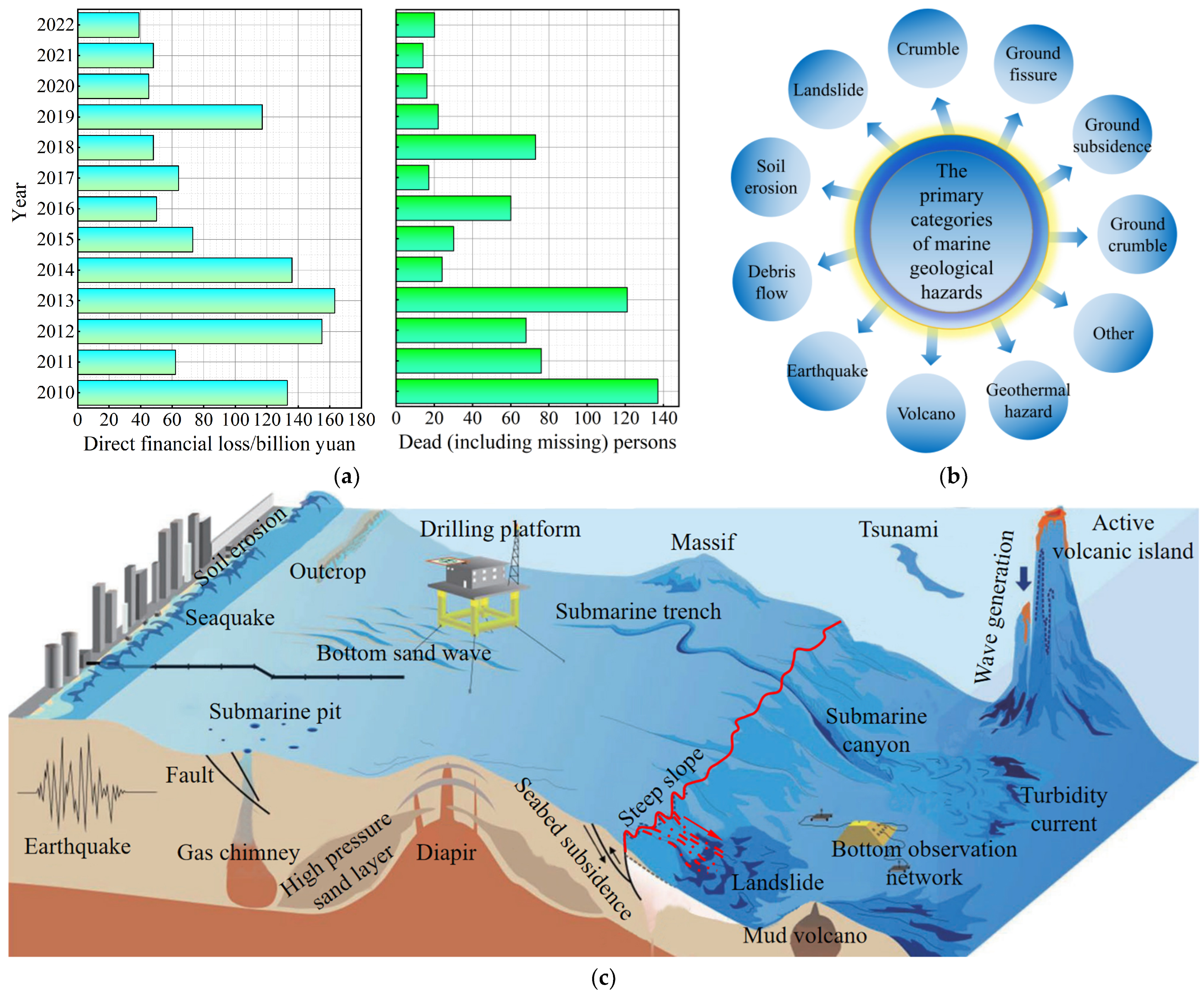
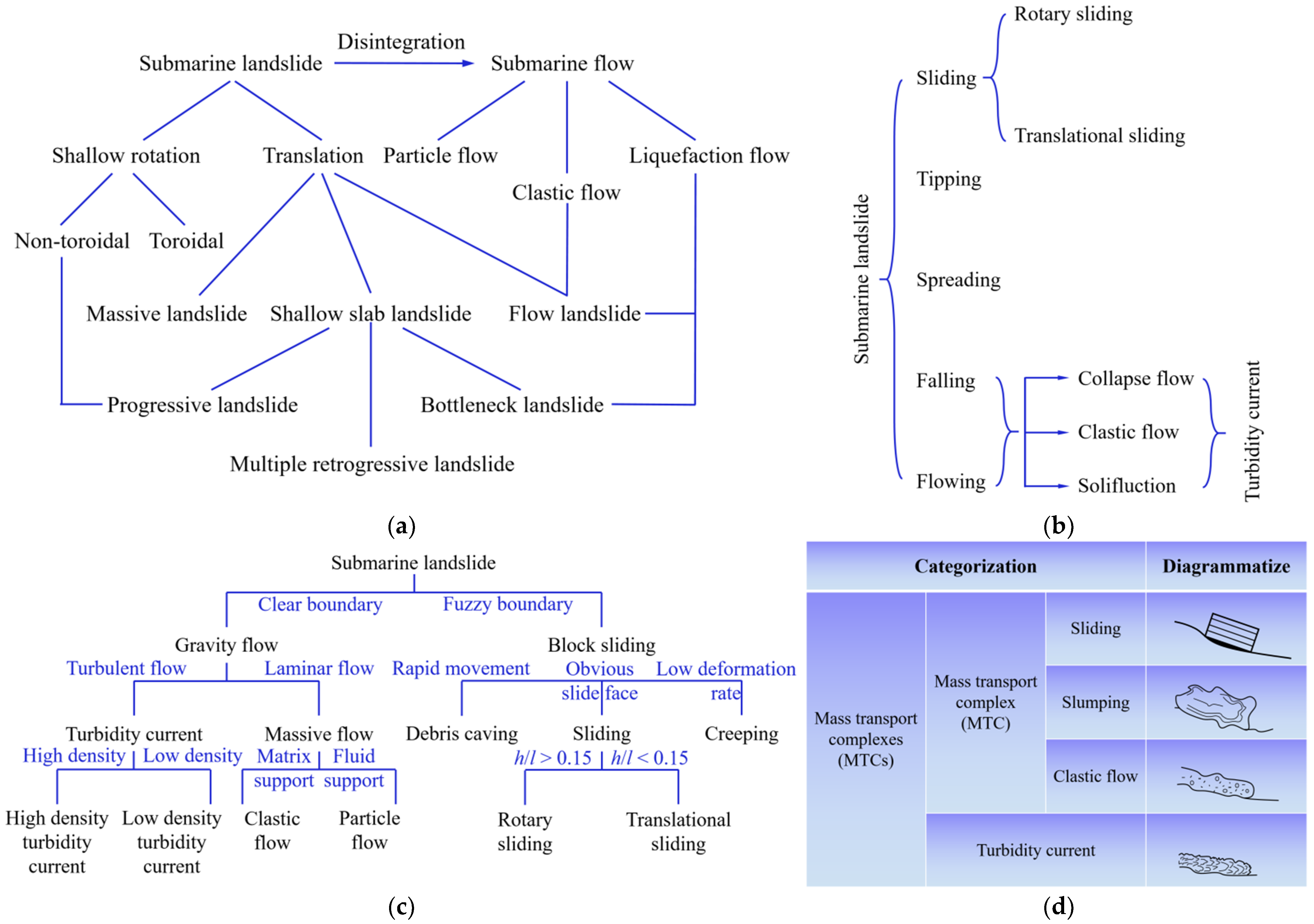
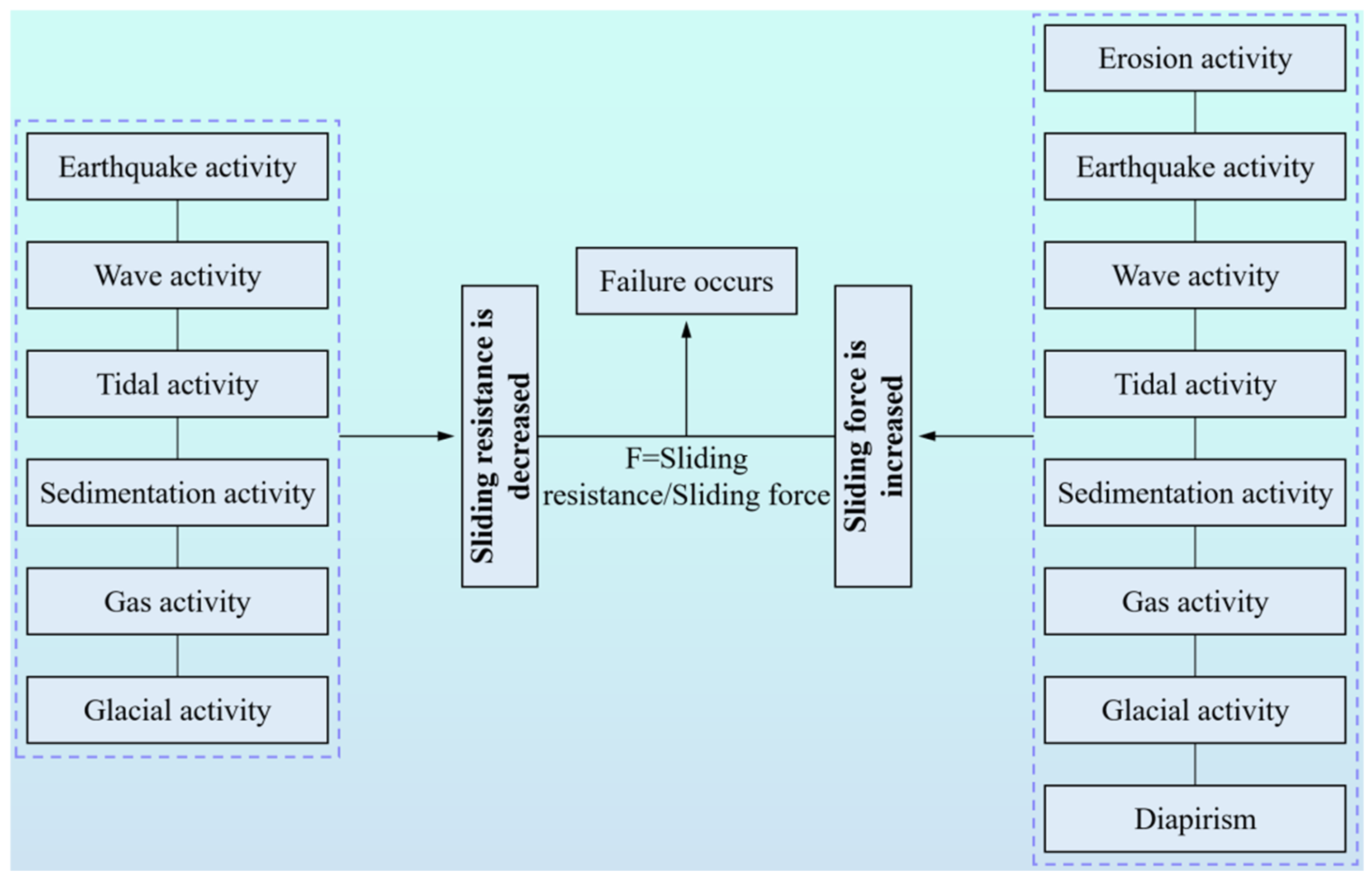
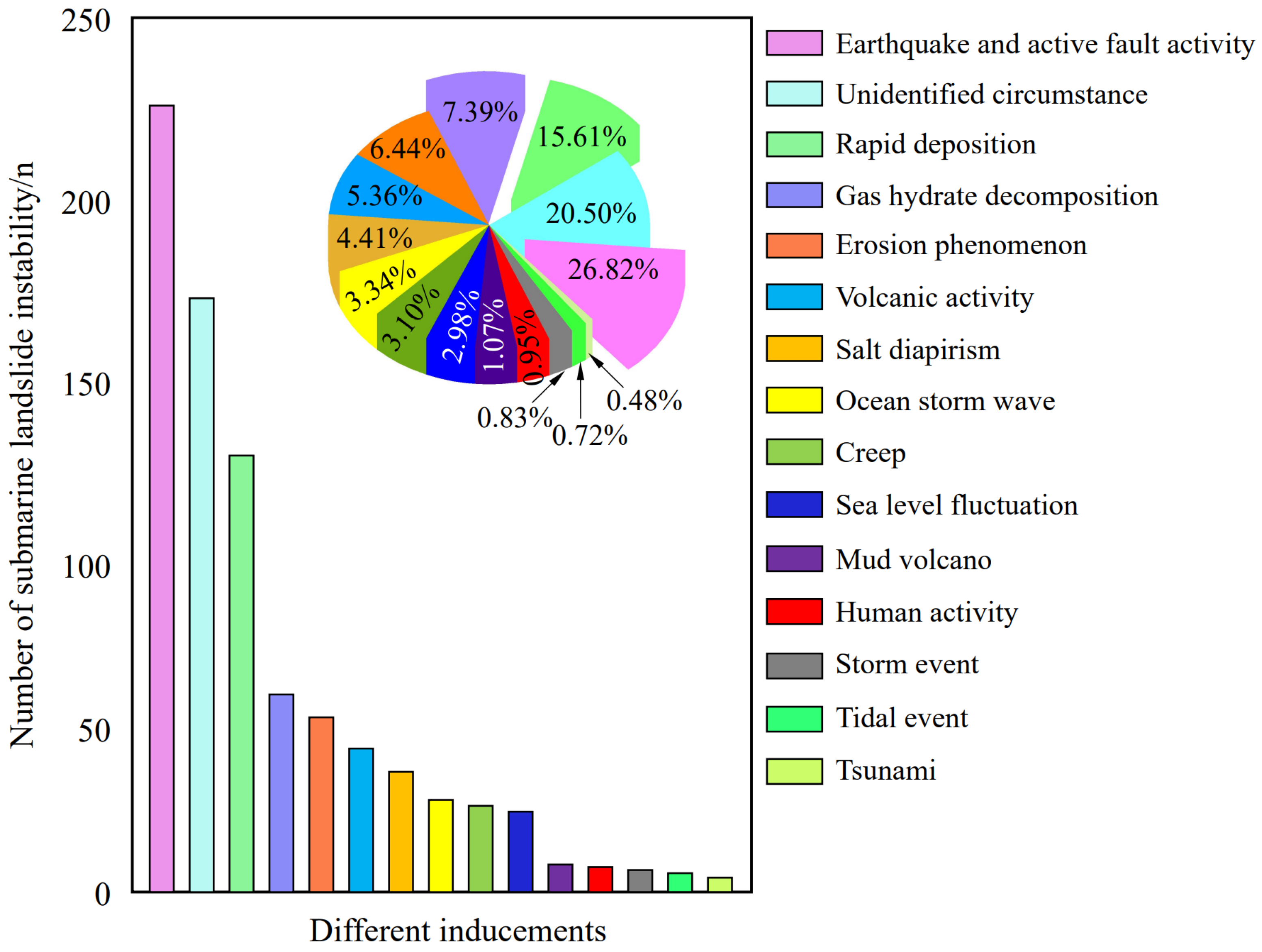
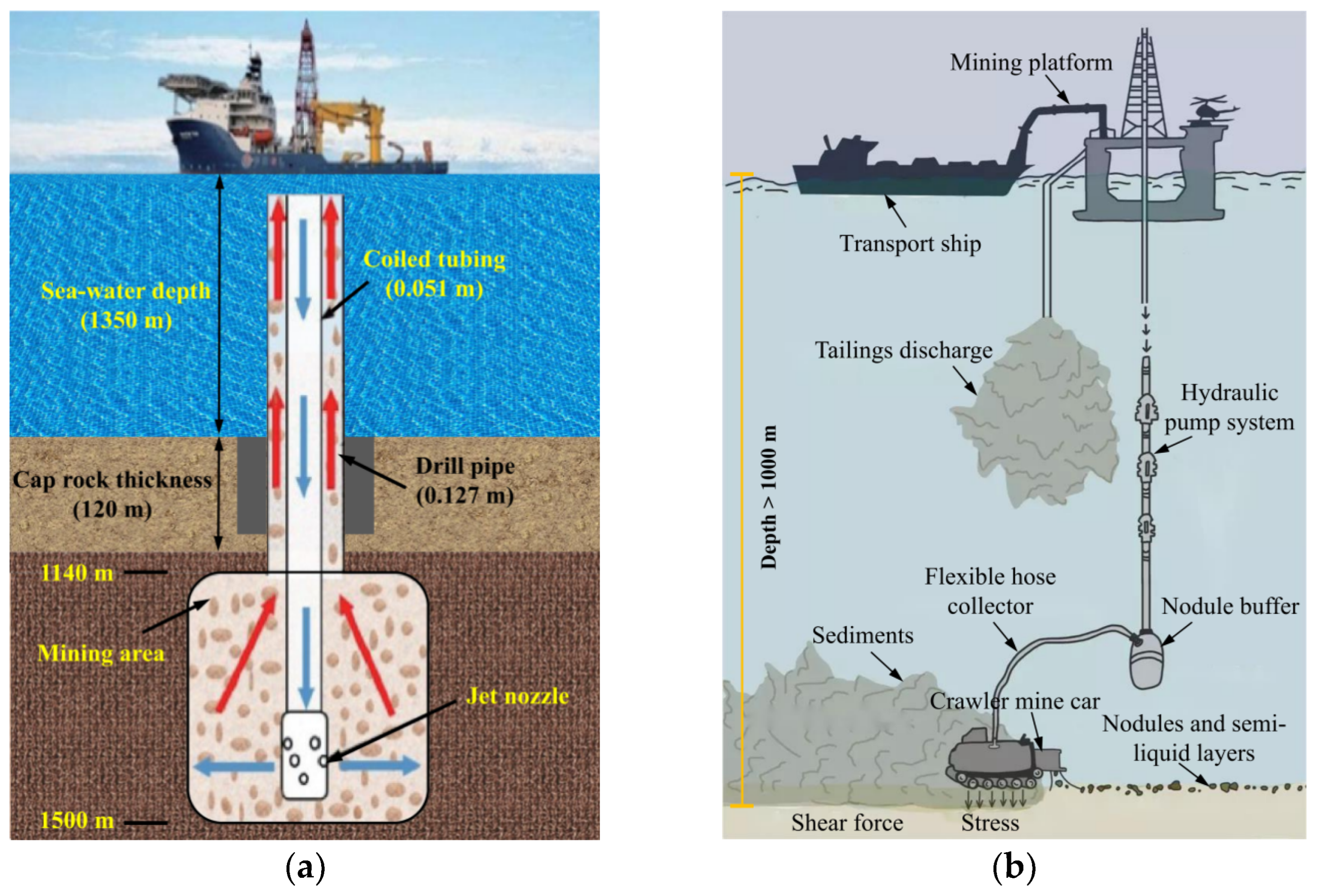
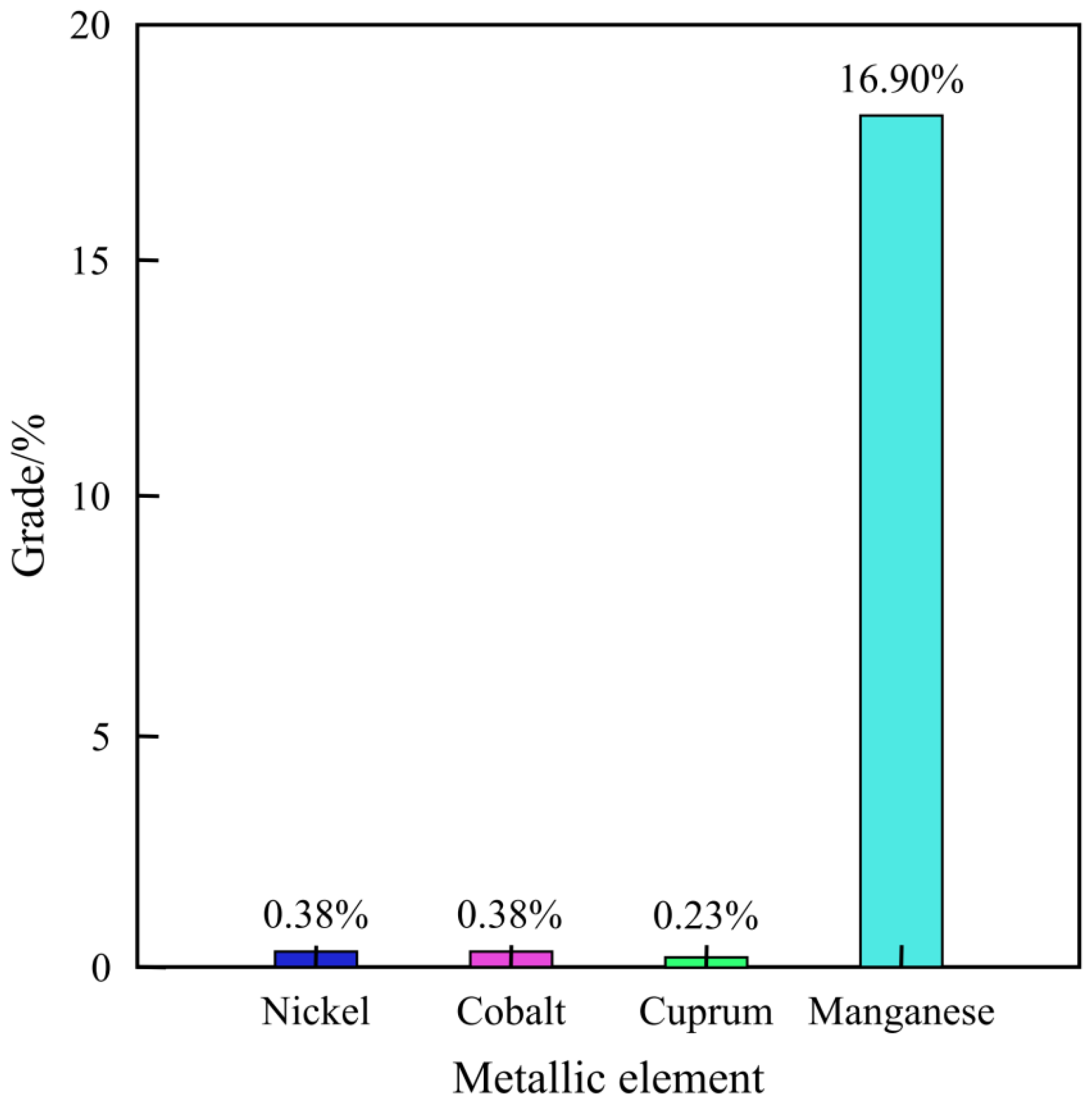

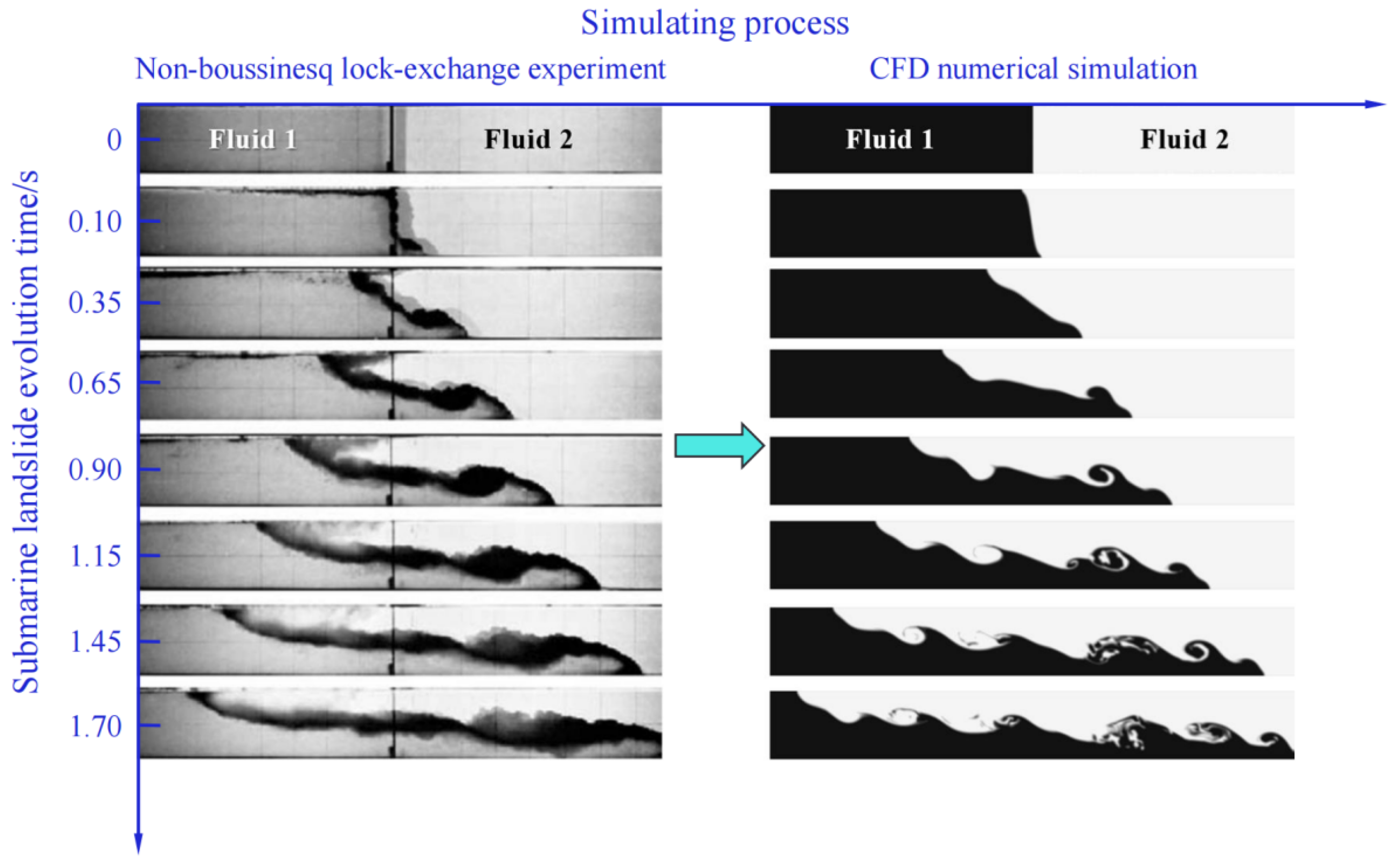
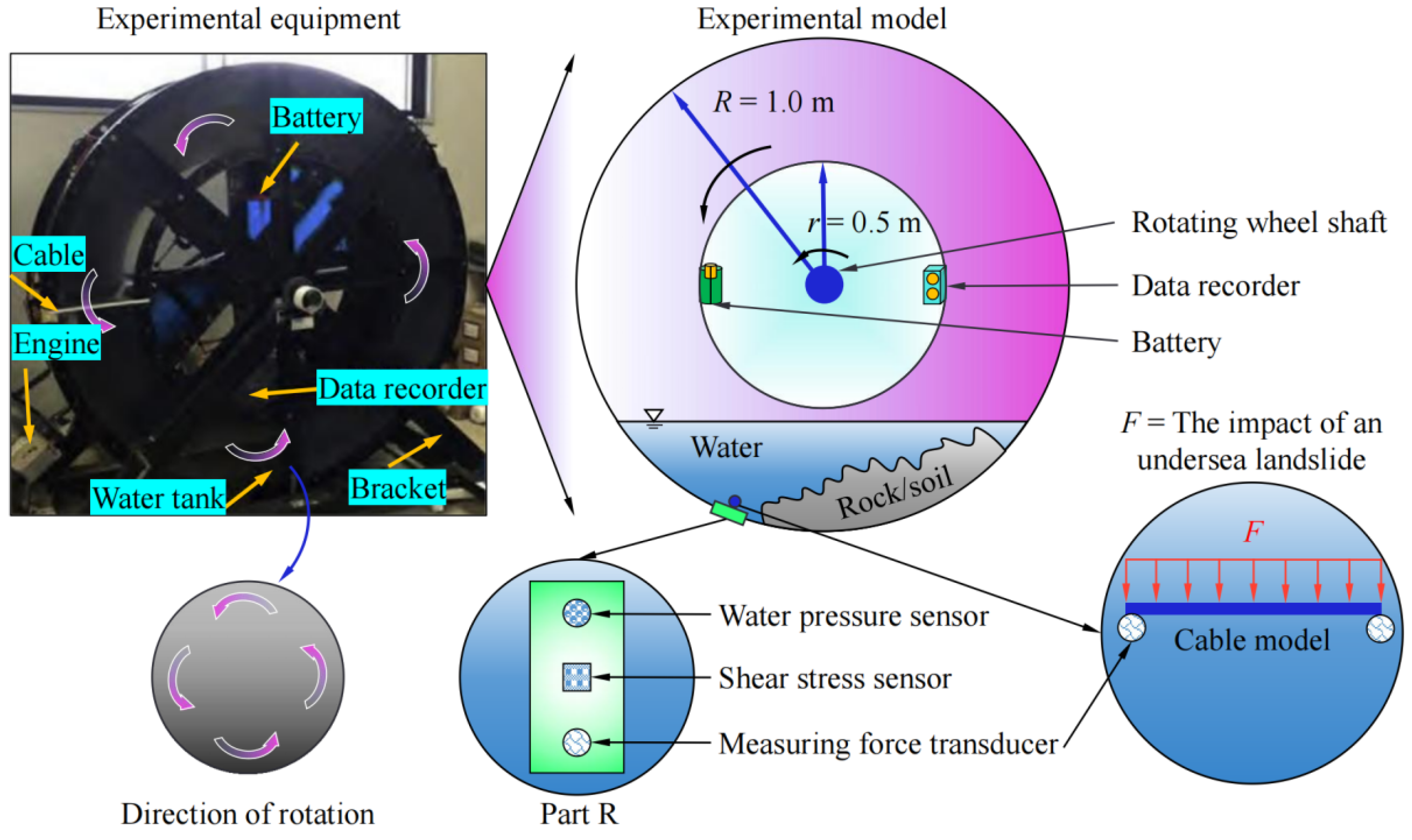
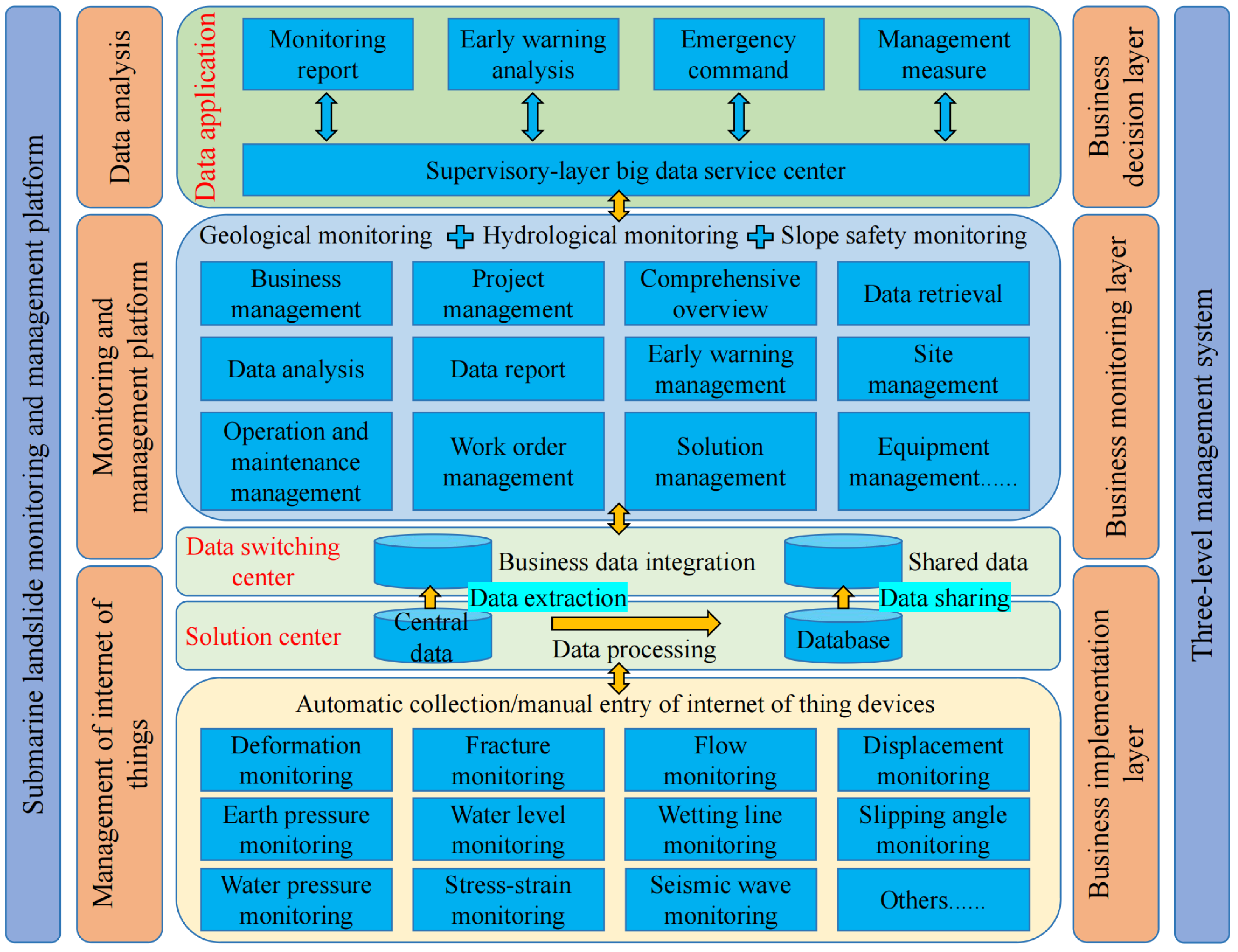
| Authors | Year | Inducements | Research Types | Research Contents | Research Results |
|---|---|---|---|---|---|
| Prior and Jin [56] | 1983 | Geological structure | Geological surveys | The impact of submarine landslides on deep-sea engineering was examined. | The deep-sea landslide was qualitatively described and classified, while its triggering mechanism was analyzed. |
| Chen [57] | 1988 | Submarine earthquake | Geological surveys | The categorization of deep-sea landslides and its research implications were expounded. | The deep-sea landslides can be classified into three types: liquefaction, collapse, and slide-sheet. |
| Lee [58] | 1990 | Geological structure | In situ long-term observations | The verification of submarine landslides can be achieved through observations of buildings, cables, submarine topography, and strata. | The distribution scale and morphological characteristics of submarine landslides were elaborated. |
| Kou [59] | 1990 | Submarine earthquake | Geological surveys | Application of high-resolution seismic, 3.5 kHz shallow profile and side sonar seabed scanning. | Submarine landslides existed in the northern part of the South China Sea. |
| Jiang and Leblond [60] | 1992 | Submarine earthquake | Numerical simulations | A numerical model was developed to simulate submarine landslides and their interaction with surface waves. | The density of the landslide material and the water depth at the site are two crucial parameters. |
| Yin et al. [61] | 2000 | Dynamic of ocean circulation | Field surveys and experiments | A more comprehensive study and field trial on submarine landslides has been conducted. | The primary driver of submarine landslides is the dynamics of ocean circulation. |
| Zhu [62] | 2006 | Submarine earthquake | Physical exploration | Three seismic units of a submarine landslide in the Qiongdong–Yinggehai basin area of the South China Sea were studied. | The triggering mechanism of submarine landslides may be attributed to frequent fluctuations in sea level, and the release of gas hydrates. |
| Wu et al. [63] | 2008 | The release of gas hydrates | Geological surveys | The method for assessing geological risks associated with submarine landslides was proposed. | Abnormal sediment overpressure may facilitate the initiation of submarine landslides. |
| Liu et al. [64] | 2010 | The release of gas hydrates | Numerical simulations | Quantitative assessment of submarine slope instability induced by hydrate decomposition. | The further increase in slope angle exacerbates the instability of submarine slopes. |
| Ruan et al. [65] | 2012 | Seismic impacts | Numerical simulations | The seismic experiment of 3D array of OBS in the southwestern sub-basin of the South China Sea (SCS). | The results indicate that the spreading ridge in the SCS is experiencing compressive stress caused by seismic shear waves. |
| Yin et al. [66] | 2014 | Rapid changes in climate | Geological surveys | The relationship between submarine landslides and climate change was analyzed. | Submarine landslide triggers may be closely related to rapid climatic transitions. |
| Li et al. [67] | 2015 | Weak properties of rock and soil mass | Physical exploration | The evolution of small submarine landslides in the northern part of the South China Sea was studied. | Small submarine landslides may be caused by weak properties of rock and soil mass. |
| Zhang and Lu [68] | 2015 | The release of methane hydrate | Numerical simulations | The numerical analysis of thickness propagation in a layered fault was conducted. | It enriched the failure mechanism of marine landslides. |
| Zhang et al. [69] | 2016 | Storm surge | Physical exploration | They examined mechanisms of submarine landslides triggered by storm surge. | The storm wave was the main factor in submarine slope instability. |
| Zhou et al. [70] | 2017 | Submarine earthquake | Laboratory testing | Detailed laboratory experimental study of a soft sensitive marine clay. | The depth of soil disturbance significantly affects submarine slope displacement. |
| Cheng et al. [71] | 2018 | Submarine earthquake | Monitoring- warning | The instability characteristics of water-bearing sediments in the southwest offshore of Taiwan was studied. | The submarine slope may fail due to the disturbance of the BSR * caused by the thrust fault. |
| Jiang et al. [72] | 2018 | Submarine earthquake | Numerical simulations | Computational fluid dynamics method was utilized to simulate submarine landslides under seismic activity. | The presence of methane hydrate can increase the strength and decrease the damping of the sediment. |
| Sun et al. [73] | 2019 | Hydration deficiency | Numerical simulations | A fully coupled THCM * model was applied to study the mutiphysical responses of GHBSs *. | The difference between the hydrate zones affects the multi-physical field response of submarine landslides. |
| Zhang et al. [74] | 2020 | Geological structure | Numerical simulations | The mechanism of plane shear zone propagation in submarine landslides was investigated. | New criteria for the catastrophic propagation of a planar shear band were proposed. |
| Zhang and Puzrin [75] | 2021 | Geological structure | Numerical simulations | The whole evolution process of submarine landslides was simulated, including pre- failure shear zone extension, and post-failure dynamics. | The numerical results from the proposed method are comparable to the large deformation finite element analysis. |
| Wang et al. [76] | 2021 | Seismic impacts | Geographic information system | The influence of the initial seismic impact on the stability of the submarine slope in the South China Sea was studied. | The results indicate that the initial seismic impact has a significantly uneven impact on the stability of the submarine slopes. |
| Xie et al. [77] | 2021 | Seismic impacts | Data analysis | The seismic data of magnitude 4.5 and above in the waters of China and the surrounding areas were fitted. | The results provided empirical formulas to unify magnitude scales for the earthquakes in China’s seas and neighboring regions. |
| Nian et al. [78] | 2022 | The release of methane hydrate | Laboratory testing | Submarine slope failure triggered by overpressure fluid associated with gas hydrate dissociation was investigated. | The submarine slope failure pattern can be generalized into two types: (a) disc-shaped failure and (b) penetration failure. |
| Li et al. [79] | 2022 | Submarine earthquake | Numerical simulations | A general approach was proposed to predict the earthquake response and to assess the post-earthquake stability of submarine slopes. | The proposed method was practical and efficient for evaluating the stability of submarine slopes during earthquakes. |
| Guo et al. [80] | 2023 | Geological structure | Numerical simulations | A fluidized submarine landslide with shear thinning non-Newtonian fluids over a seabed in the ambient water was simulated. | The proposed research methodology offered a crucial foundation for the forecasting of submarine landslides. |
| Liu et al. [81] | 2023 | Weak properties of rock and soil mass | Laboratory testing | A series of steady rheological tests were conducted on samples of three soils with different water contents and temperatures. | The results of this study could be useful for deep-sea submarine mudflow and landslide modelling. |
| Classification Basis | Classification | Classification Standard |
|---|---|---|
| Sliding body scale (volume/104 m3) | Minor-scale landslide | <3 |
| Medium-scale landslide | 3~50 | |
| Large-scale landslide | 50~300 | |
| Super large-scale landslide | >300 | |
| Sliding body thickness (thickness/m) | Shallow landslide | <6 |
| Midlevel landslide | 6~20 | |
| Thick landslide | 20~50 | |
| Super thick landslide | >50 |
| Class of Interest | Organization | Country | Time | Nickel | Cobalt | Cuprum | Manganese |
|---|---|---|---|---|---|---|---|
| ISA | MIT * | USA | 2022 | 22,962 | 55,535 | 6965 | 1640 |
| Stakeholder | AG * | Africa | 2022 | 14,840 | 91,000 | 6886 | 2040 |
| Organization of mining developed countries | BWMi * | Germany | 2021 | 14,922 | 28,946 | 6745 | 990 |
| Organization of mining developing countries | COMRA * | China | 2021 | 12,862 | 64,855 | 6500 | 1685 |
| Mining company representative | GSR * | Belgium | 2022 | 16,312 | 48,475 | 4725 | 1560 |
| Mean value | 16,379.6 | 57,762 | 6364 | 1583 | |||
| Class of Interest | Organization | Country | Time | Nickel | Cobalt | Cuprum | Manganese |
|---|---|---|---|---|---|---|---|
| ISA | MIT * | USA | 2022 | 95% | 85% | 90% | 90% |
| Stakeholder | AG * | Africa | 2022 | 95% | 85% | 90% | 95% |
| Organization of mining developed countries | BWMi * | Germany | 2021 | 95% | 85% | 95% | 90% |
| Organization of mining developing countries | COMRA * | China | 2021 | 87% | 83% | 88% | 90% |
| Mining company representative | GSR * | Belgium | 2022 | 95% | 85% | 95% | 90% |
| Mean value | 93% | 85% | 92% | 91% | |||
Disclaimer/Publisher’s Note: The statements, opinions and data contained in all publications are solely those of the individual author(s) and contributor(s) and not of MDPI and/or the editor(s). MDPI and/or the editor(s) disclaim responsibility for any injury to people or property resulting from any ideas, methods, instructions or products referred to in the content. |
© 2024 by the authors. Licensee MDPI, Basel, Switzerland. This article is an open access article distributed under the terms and conditions of the Creative Commons Attribution (CC BY) license (https://creativecommons.org/licenses/by/4.0/).
Share and Cite
Li, Z.; Li, Q. Balancing Submarine Landslides and the Marine Economy for Sustainable Development: A Review and Future Prospects. Sustainability 2024, 16, 6490. https://doi.org/10.3390/su16156490
Li Z, Li Q. Balancing Submarine Landslides and the Marine Economy for Sustainable Development: A Review and Future Prospects. Sustainability. 2024; 16(15):6490. https://doi.org/10.3390/su16156490
Chicago/Turabian StyleLi, Zuer, and Qihang Li. 2024. "Balancing Submarine Landslides and the Marine Economy for Sustainable Development: A Review and Future Prospects" Sustainability 16, no. 15: 6490. https://doi.org/10.3390/su16156490
APA StyleLi, Z., & Li, Q. (2024). Balancing Submarine Landslides and the Marine Economy for Sustainable Development: A Review and Future Prospects. Sustainability, 16(15), 6490. https://doi.org/10.3390/su16156490






